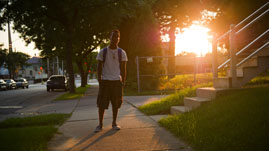Teachers' Domain - Digital Media for the Classroom and Professional Development
User: Preview

Source: Produced by the Wisconsin Educational Communications Board.
This multimedia video produced by the Wisconsin Educational Communications Board features Elijah Furquan, a spoken word artist in Milwaukee, WI, who describes the effects of extreme heat on his urban community.
Though Wisconsin is notorious for frigid winters, extreme heat kills more people in the state than all other weather disasters (e.g., tornadoes, floods, blizzards) combined. Just as the human body can freeze to death when temperatures are too cold, it can also stop functioning properly when it cannot dissipate excessive heat. At least 68 people died during an extreme heat event in 1995 in Wisconsin, when temperatures soared over 90ºF for seven consecutive days. On the hottest days with high humidity, temperatures felt like they were over 120ºF.
There is no universal definition of a dangerous extreme heat event. The National Weather Service determines what constitutes an extreme heat event in relation to a specific place and time of year. For example, a mid-summer extreme heat event in Sheboygan, WI, may have the same characteristics as an average summer day in hot and humid New Orleans, LA. The National Weather Service issues an Excessive Heat Warning/Advisory when an extreme heat event is expected within the next 12–48 hours; though criteria vary, this typically means experiencing heat and humidity that feel like 105ºF or greater for two or more consecutive days.
It is too simplistic to completely blame extreme heat deaths on the weather. Extreme heat health problems are also related to urbanization and social, economic, and physiological vulnerability. How we design and construct our cities may further exacerbate heat-related health problems. Urban construction typically conducts more heat, retains less water, and thus increases temperatures compared to the natural environments it replaces. This is commonly referred to as the “urban heat island” effect.
More than half of the world’s population lives in urban areas. These people face an increased frequency of extreme heat episodes resulting from the combined effects of urban heat islands and increased temperatures due to climate change. Socially isolated, elderly individuals are especially vulnerable to extreme heat events. Elderly individuals are physiologically less efficient at dissipating heat. Many also have pre-existing health problems, take medications that cause dehydration, and have limited mobility. People living in poverty may have limited access to air conditioning, relief from the heat, and medical care, thereby increasing vulnerability to extreme heat. Many of the heat deaths in Milwaukee County, Wisconsin, in 1995 occurred in areas where large proportions of residents live in poverty.
According to research conducted by the Wisconsin Initiative on Climate Change Impacts, extreme heat events are projected to become more frequent, longer lasting, and geographically widespread. By the middle of the century, Wisconsin residents are projected to experience 1.5 to 4 more weeks of daytime temperatures exceeding 90ºF. Public health officials and concerned citizens will be charged with the task of protecting the most vulnerable populations in the face of these changes.
Here are suggested ways to engage students with this video and with activities related to this topic.
 Loading Standards
Loading Standards